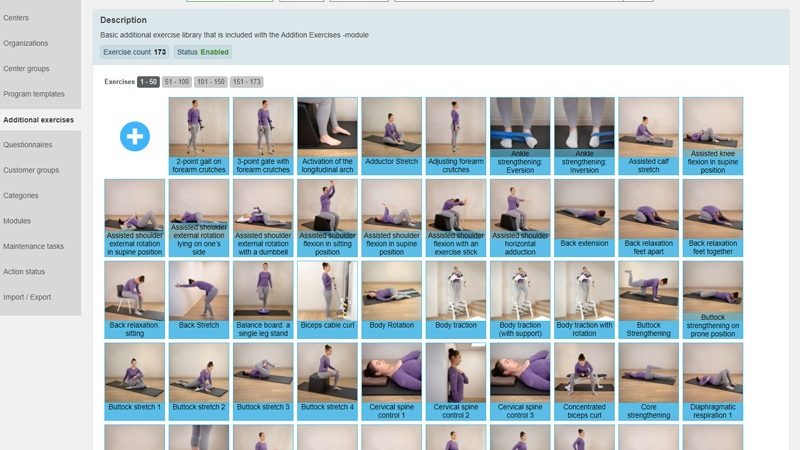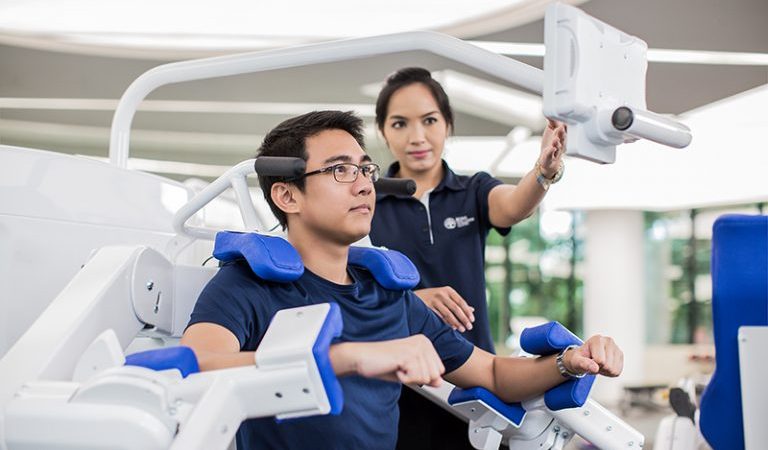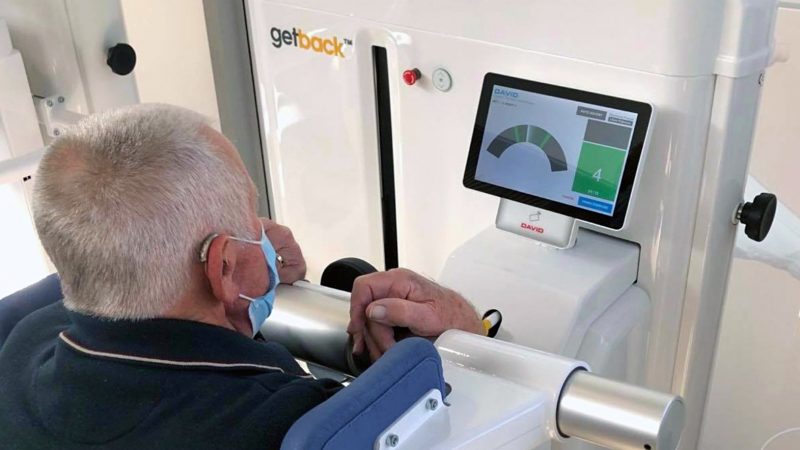Medical exercise therapy should be structured and personalized
Kalervo is a retired 69-year-old man with a history of health issues including two recent cerebral infarctions, or silent strokes. This significantly decreased Kalervo’s motor skill capabilities and caused him to rely on walking aids including a walker and walking cane.
After his stroke, the initial rehabilitation program his doctors set up for him was random and not structured at all. Kalervo did not feel that this therapy was helping. After being discharged from the hospital and given permission to begin active exercise therapy, Kalervo’s friend Maritta brought him to the Nordic Health clinic for rehabilitation. Kalervo began visiting the Nordic Health clinic two times a week.
In the beginning of this treatment program, Kalervo was only able to walk about 200 meters with a walker. However, as his treatment program progressed, he began noticing improvement in mobility and pain levels.
Device exercise therapy improves mobility and independence
“The device exercise therapy is good, and I enjoy it. After my last stroke, my overall mobility was very poor. The exercise therapy has been useful, and I feel I have made progress in my overall mobility. I am a lot more independent than I was a few months ago.”
Together with the physiotherapist at Nordic Health, a treatment plan and goal were created to guide Kalervo’s rehabilitation journey. “My current goal is to improve my walking. Training with the hip devices has decreased my hip pain. This is encouraging because I can actually see and feel the progress I have made.”
“The exercise therapy has been useful, I am a lot more independent than I was a few months ago.”
Along with exercise therapy at Nordic Health, Kalervo has also had occupational therapy sessions and does additional exercises at home.
EVE shows rehabilitation progress in a coherent patient report
The clinic physiotherapist or trainer uses the David devices to perform mobility and isometric strength tests to determine the patient’s situation. These can be done throughout the rehabilitation program for a better understanding of the patient’s mobility and strength.
Kalervo was tested before his two silent strokes in 2020, as well as in October 2021 during his current rehabilitation treatment program. His EVE report is shown below.
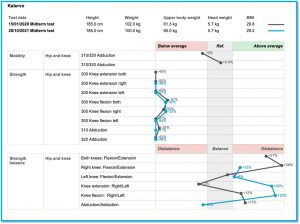 The patient’s EVE report shows strength and test results in a clear way.
The patient’s EVE report shows strength and test results in a clear way.
In the EVE graphic report, Kalervo’s initial test results before his two strokes are shown in gray. His current mobility and isometric strength results are in blue. “The EVE report shows that Kalervo’s strength and mobility are nearing the levels they were at before his strokes. It shows he is making progress” says Hanna, a trainer at Nordic Health clinic. She works closely with Kalervo during his training visits to the clinic. “The EVE report shows that we do need to pay attention to Kalervo’s strength balance since his right side is stronger than his left, which suffered due to the strokes.”
“The EVE report shows we need to pay attention to his strength balance since his right side is stronger than his left, which suffered due to the strokes.
EVE reporting is a versatile and coherent way to show a patient’s rehabilitation or training progress. Physiotherapists and clinic personnel can conduct mobility and strength tests with their patients whenever they like. For example, initial testing before beginning a treatment program, midterm testing during the program, and outcome testing to see the final results after the treatment program.
All testing data is automatically stored in EVE. With a few simple clicks on the EVE platform, the therapist can print out or email the report for the patient. Objective data from mobility and strength testing is valuable because it provides a better understanding of a patient’s progression and motivates the patient to continue as they can see their progress in a clear, understandable way.
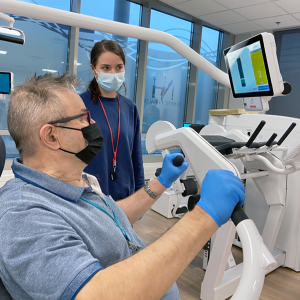 Kalervo exercises on the G510 chest press while clinic instructor Hanna looks on.
Kalervo exercises on the G510 chest press while clinic instructor Hanna looks on.
A personalized exercise program ensures safe and effective training
His friend Maritta was the one who encouraged him to start exercise therapy at the clinic for effective rehabilitation.
“I have been to other gyms before and done training there. When I began training at Nordic Health, I quickly realized this was something much better.” The ability to personalize the training program stood out for Maritta as a special opportunity to exercise regardless of one’s health history. “I have had a back surgery and problems with shoulder pain. Together with the clinic trainer we were able to customize my training program to meet my specific needs. When I exercise with the devices, I don’t feel any pain and I can feel that it is effective”.
Together with the clinic trainer, we were able to customize my training program to meet my specific needs.
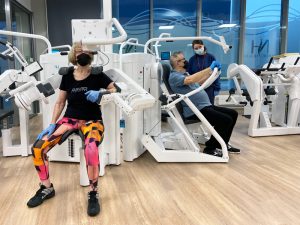 Maritta exercises her shoulder with the G640 Glenohumeral internal rotation device.
Maritta exercises her shoulder with the G640 Glenohumeral internal rotation device.
Maritta enjoys the environment and staff at Nordic Health. “The clinic personnel are the best because they are all so friendly, professional, and always available to help and answer questions.” Maritta also says “the white sleek devices also make the place feel clean and welcoming.”
Medical exercise therapy helps patients recovering from a stroke
Device training during the rehabilitation stage can help stroke patients as well as other patients with neurological diagnoses.
According to the ACSM (American College of Sports Medicine) guidelines for individuals suffering a cerebral vascular accident it is advised to “use equipment and exercise that improve safety in those with deficits”. Device training is safe because it allows for structured training with distinct parameters including weight resistance and range of motion.
With David devices, this is made even easier because EVE remembers the correct weights for each exercise and the terminal screen shows the correct range of motion and speed the patient should follow.
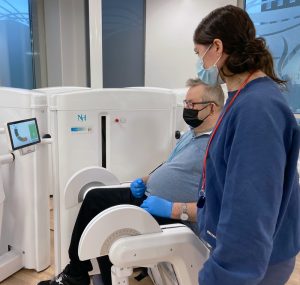 Kalervo trains on the G200 Knee extension device.
Kalervo trains on the G200 Knee extension device.
A study published by the American Heart Association recommends physical activity for patients recovering from a stroke. This includes muscle-strengthening activity. The study highlights that “physical activity goals and exercise prescription for stroke survivors need to be customized for the individual to maximize long-term adherence”.
“We continually customize the program by adjusting weight resistance and range of motion to be suitable for his current situation.”
With exercise therapy on the David devices, this customization is a guarantee. As Hanna explains, “we continually customize Kalervo’s program by adjusting the weight resistance and range of motion to be suitable for his current situation. When he trains he gives feedback after each exercise and EVE adjusts the program based on Kalervo’s feedback.” The clinic personnel also follow along on the EVE platform to see Kalervo’s compliance scores from each exercise and can intervene when they see possible issues.
References:
ACSM | The American College of Sports Medicine. (2022). Retrieved 17 January 2022, from https://www.acsm.org/
Billinger, S., Arena, R., Bernhardt, J., Eng, J., Franklin, B., & Johnson, C. et al. (2014). Physical Activity and Exercise Recommendations for Stroke Survivors. Stroke, 45(8), 2532-2553. doi: 10.1161/str.0000000000000022
 English
English 























